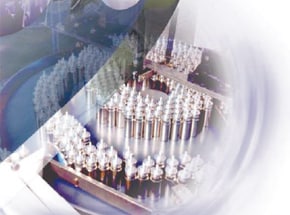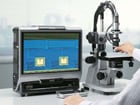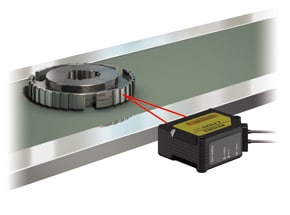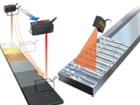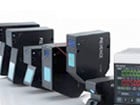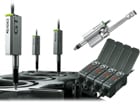Case Studies
- KEYENCE VHX-970F Microscope Proves that Knowledge is Power at TDK-Lambda UKNew
-
TDK-Lambda UK, a major manufacturer of power supplies to markets such as medical and industrial, is taking advantage of a newly installed KEYENCE VHX-970F high-accuracy digital microscope to drive the company’s inspection and quality function. With such a reputable global brand, there is no margin for failures.
- KEYENCE Vision Systems used as standard across Shawpak's Medical Packaging Machines
-
SHAWPAK is the market leader for standard and bespoke medical packaging machinery. Trusted by medical device and pharmaceutical manufacturers across the globe, Shawpak is known for their innovative packaging solutions. Their range of standardised machines uses proven technology to keep costs low and quality high, while their bespoke options keep things custom and flexible.
- SEWTEC Automation Uses KEYENCE IV2 Vision Sensors to Manufacture Plastic-Free Poppy
-
SEWTEC Automation Limited is the predominant Machine Builder in the UK for custom-made industrial automation solutions. The company excels at inventing and innovating, creating original and bespoke machines for any industry based on the customer’s needs and challenges. SEWTEC has a global presence and a proven track record of delivering effective and reliable automation systems.
- KEYENCE VHX-7000 4K Digital Microscope helps archaeologists improve their understanding of the ancient world
-
The Archaeology Department of the University of Liverpool has carried out two ground-breaking projects that have improved our understanding of how human culture developed in ancient times. Playing a key role in that research has been the KEYENCE VHX-7000 Series Digital Microscope, the world's first 4K ultra-high accuracy microscope.
- Vision Labs can see clearly now thanks to KEYENCE
-
More than six in 10 people in the UK have some requirement for glasses, meaning the range of lens combinations required to suit all of their needs is almost infinite. Significant effort goes into the cutting, polishing and treatment of every lens. Given the importance of ensuring the correct prescription, and the proximity of the lens to the wearer's eye, any sort of defect simply cannot be countenanced.
- Taking Defect Analysis of Materials to a Whole New Level
-
Quality control specialists working within the manufacturing environment, or experts in research and development (R&D) working on product prototypes, need to have a complete picture of any defects that exist in the materials they work with. This is the case whether components are metal, plastic or a composite.
- Ensuring Semiconductor Quality by Getting Up Close
-
In the electronics and semiconductor industry, the trend over many decades has been to miniaturise components to satisfy the ever-increasing demand for wearable and mobile devices that have far more processing power than many desktop computers.
- IM-7500 Image Dimension Measurement System takes complex component readings quickly, easily and accurately
-
Aerotron Avotec is a maintenance and repair organisation in the aviation industry that specialises in the repair and overhaul of a variety of rotary and fixed wing aircraft components for civil and military customers. The company is based in Scotland. Aerotron Avotec is renowned for its technical excellence and meticulous approach to repairs as well as offering one of the lowest warranty rates in the aerospace industry.
- Instant High-Precision Measurement System Slashes Final Inspection Failures and Pays for Itself in Months
-
Based in Glenrothes, Scotland, Euro Precision is a medium-sized precision engineering company that over recent years has experienced a period of substantial growth. As a leading subcontract engineering company, manufacturing critical precision components and assemblies to exacting quality standards, Euro Precision now has customers in a range of industry sectors, including aerospace, medical, oil & gas and automotive.
- Instant High-Precision Measurement System Cuts Inspection Time for Presspahn
-
Specialist engineering solutions provider Presspahn built a reputation for supplying a range of industries with materials and components for electrical insulation, thermal insulation and mica-based insulation. The company has remained ahead of the market by adopting modern manufacturing techniques driven by innovation, precision and consistency backed by low costs and minimal lead times.
- New KEYENCE measuring system helps NEMA Ltd in its quest for the highest quality standards
-
“How long is a piece of string” goes the famous English-language saying. It may be a good answer when no obvious answer otherwise exists. But when it comes to measuring anything, getting the figures right is often a crucial part to any successful undertaking. We know this from experience: the history of engineering is littered with errors of all magnitudes – and regardless of the actual margin of error involved, outcomes can be costly. Very costly indeed.
- Public Analyst Scientific Services Using New KEYENCE Digital Microscope for Food Tests
-
KEYENCE products are designed specifically to add value to the manufacturing and research practices of its customers, regardless of geographical location. The company’s portfolio of products consists of code readers, laser markers, machine vision systems, measuring systems, microscopes, sensors, and static eliminators.
- New KEYENCE Measuring System Helps Pressure Tech Deliver High Quality Regulators
-
Japanese measuring specialist KEYENCE has been known as a leader in product innovation for many years. The company offers a wide range of measurement solutions, used in numerous businesses where quality and repeatability are non-negotiable goals. The industry-leading image dimension measurement systems KEYENCE design and manufacture allow its customers to perform accurate inspections at a level of speed and precision that is unparalleled.
- The Size is Right for Rudd Macnamara as it Acquires a New KEYENCE Instant Measuring System
-
Inspecting parts in all phases of a manufacturing process is crucial for the many customers of KEYENCE, a specialist in precision measurement and automation. The company offers a wide range of measurement and inspection products, deployed across both production, assembly line and laboratory environments, to ensure its customers achieve their quality goals. The company’s industry-leading IM Series Image Dimension Measurement systems allow customers to accurately and instantaneously perform dimensional inspections at a level of precision that was not previously possible.
- New KEYENCE digital microscope ensures both quality and safety of GC Aesthetics implants
-
Over the years KEYENCE has become a global leader in the development of measurement and quality assurance solutions. The company’s extensive line card includes sensing, vision and measurement products, along with laser markers and microscopes. KEYENCE is continuously looking to develop innovative and reliable products to meet the needs of its large customer base. These products and solutions are making their mark in every market sector, all over the world.
- KEYENCE digital microscope helps propel Roxel UK to new commercial heights
-
KEYENCE has grown to become a world leader in the development of automation and quality assurance solutions since its inception, in 1974. The company’s extensive line card includes sensing, vision and measurement products, as well as laser markers and microscopes. KEYENCE products are specifically designed to add value to the manufacturing and research practices of its customers, regardless of geographical location.
- BMI turns to KEYENCE IM Series
-
Automatic dimension measurement boosts quality at volume turned-parts manufacturer.
- GlaxoSmithKline Banks on the Flexibility of KEYENCE’s Vision Systems
-
The multinational wants to continue inspecting its products itself. Now it can fully automate its production lines and in the process, reduce the risk of human error to a minimum.
- High-Speed Inspection of Broken Biscuits
-
Nutrition & Santé is Europe’s leading maker of organic and health foods. Biscuits roll off its production lines in stacks of 4 or 5 units that are then wrapped in packs and inserted in their cardboard packaging at high speed.
- Simplifying Inspections for Timex
-
Timex is America's leading watchmaker and is present in more than 80 countries. Fralsen, its French entity, makes watch movements and used contact sensors and conventional comparators and was looking for a way to improve their inspection process.
- Measuring profiles for Faurecia Interior Systems
-
By using KEYENCE’s LJ-G sensor, the Automotive Equipment Manufacturer has automated its inspection of airbag deployment slits in vehicle dashboards. This resulted in stable measurements and a fast return on investment.
- KEYENCE CORPORATION Wins Prestigious R&D 100 Award for VHX-1000 Digital Microscope
-
As the market leader in digital microscopy, KEYENCE CORPORATION has been recognized by R&D Magazine for its developments in the field of microscopy and awarded with an R&D 100 Award. Regarded by many as the “Oscars of Innovation”, the R&D 100 Awards acknowledge and showcase the top 100 technology products of the year.
- Zero Downtime Saves Company from Headaches
-
The Problem:The automated tray loader will occasionally load a tray improperly on the conveyor track. This misloaded tray eventually crashes the production line creating downtime, machine damage and potential danger for operators.
- Low Cost Solutions: Improved Processes and Increased Customer Confidence
-
The Problem:The operators switch between jobs to keep fresh, however some components are not always placed onto the assemblies. This can create several scenarios. The first is that the assembly damages parts within the automation equipment.
- Affordable and 100% Reliable Measurement for Steel Manufacturer
-
The Problem:Gauging was performed using hand gauges, contact-type gauges, or some other less accurate indirect methods. Having no standard developed practice, workers at the plant were not taking reliable measurements.
- KEYENCE Contact Sensor Prevents Automobile Part Defects
-
The Problem:During assembly, if the diaphragm is not seated in the right place, the two halves will not seal properly creating a defective product. One half with a smaller diameter fits inside a larger one with the gasket acting as a cushion in between. During seating, a diaphragm can become “pinched” during the process sometimes creating tears and/or not allowing for the necessary tight seal required by the part.
- PLEASE
CONTACT US

